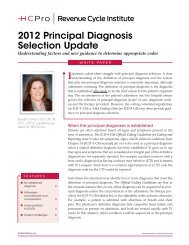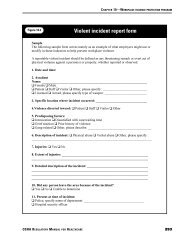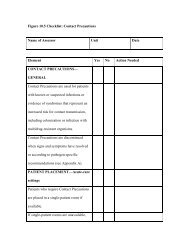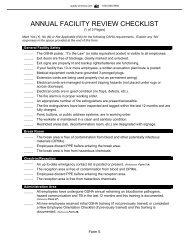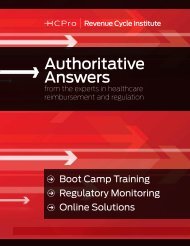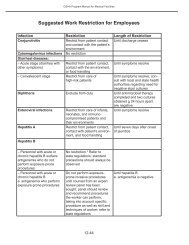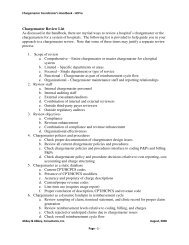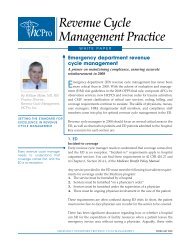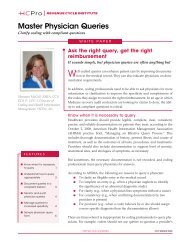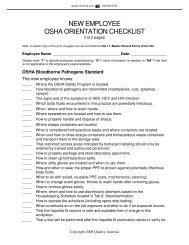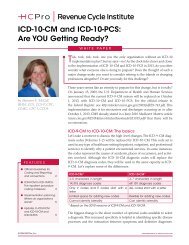Sepsis and Septicemia: Clear Up Coding and ... - HCPro Blogs
Sepsis and Septicemia: Clear Up Coding and ... - HCPro Blogs
Sepsis and Septicemia: Clear Up Coding and ... - HCPro Blogs
Create successful ePaper yourself
Turn your PDF publications into a flip-book with our unique Google optimized e-Paper software.
6 Present on Admission: Accurate reporting to ensure appropriate reimbursement October 2009<br />
■■<br />
■■<br />
■■<br />
tions (SD) above the normal for age<br />
Altered mental status<br />
Significant edema or positive fluid balance (i.e., 20 mL/kg over<br />
24 hrs)<br />
Hyperglycemia (i.e., plasma glucose higher than 120 mg/dL or<br />
7.7 mmol/L) in the absence of diabetes<br />
In addition, the physician should document any present inflammatory<br />
variables, such as:<br />
■■<br />
Leukocytosis (i.e., WBC count greater than 12,000/L)<br />
■■<br />
Leukopenia (i.e., WBC count less than 4,000/L)<br />
■■<br />
Greater than 10% immature forms<br />
––<br />
Includes “b<strong>and</strong>s,” “matamyelocytes,” “myelocytes”<br />
––<br />
Also known as “b<strong>and</strong>emia”—“left shift”<br />
■■<br />
Plasma C-reactive protein over two SD above the normal value<br />
■■<br />
Plasma procalcitonin over two SD above the normal value<br />
The physician should<br />
also be sure to note any<br />
variables present that may<br />
help qualify possible organ<br />
dysfunction.<br />
The physician should also be sure to note any variables present that may<br />
help qualify possible organ dysfunction:<br />
■■<br />
Arterial hypotension<br />
■■<br />
Systolic blood pressure less than 90 mm Hg<br />
■■<br />
Mean arterial pressure less than 70 mm Hg<br />
■■<br />
A systolic blood pressure decrease of greater than 40 mm Hg<br />
in adults or two SD below normal for the patient’s age<br />
■■<br />
SvO2 less than 70%<br />
■■<br />
Cardiac index greater than 3.5 L/min/M2<br />
This also includes other organ dysfunction variables. For example:<br />
■■<br />
Arterial hypoxemia (i.e., PaO2/FiO2 ratio less than 300)<br />
■■<br />
Acute oliguria (i.e., urine output less than 0.5 mL/kg*hr or<br />
45 mmol/L for at least two hours)<br />
■■<br />
Creatinine increase of 0.5 mg/dL<br />
––<br />
A definition of acute renal failure<br />
––<br />
Acute kidney injury (585.9) requires only 0.3 mg/dl rise<br />
■■<br />
Coagulation abnormalities (INR [international normalized ratio]<br />
> 1.5 or aPTT > 60 seconds)<br />
■■<br />
Ileus (i.e., absent bowel sounds)<br />
■■<br />
Thrombocytopenia (i.e., platelet count < 100,000/L)<br />
■■<br />
Hyperbilirubinemia (i.e., plasma total bilirubin > 4 mg/dL or<br />
70 mmol/L)<br />
The physician should also document any tissue perfusion variables that may<br />
be present, such as hyperlactatemia (i.e., over 1 mmol/L) or decreased capillary<br />
refill or mottling. Coders should also recognize that some physicians<br />
may underst<strong>and</strong> sepsis differently. For example, physicians who attended<br />
medical school 30 years ago may refer to a condition as “sepsis” or “sepsis<br />
syndrome,” but may actually be describing what is now known as “severe<br />
© 2009 by <strong>HCPro</strong>, Inc. Any reproduction is strictly prohibited. For more information, call 877/233-8734 or visit www.revenuecycleinstitute.com.



